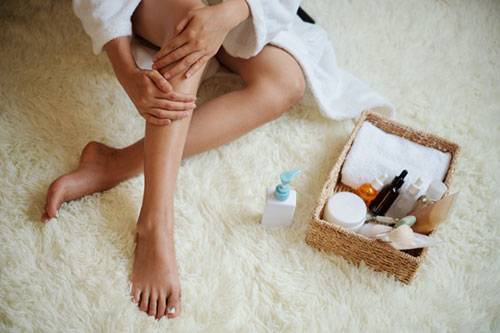
When we think about skincare, most people focus primarily on the face, often neglecting other areas of the body that deserve just as much attention — like the hands and legs. These areas are constantly exposed to environmental factors which can lead to dryness, impaired skin barrier and even a few skin diseases.
We are exposed to chemicals, preservatives and fragrances in products like soaps, hand sanitizers, etc. that are used in our daily routine. These can cause impaired skin barrier, especially over the hands and feet, that further leads to the penetration of these products to the deeper layers of the skin. The skin over the hands and legs are more prone to eczema in winter. Hence, use soaps or handwashes with more glycerine content and check for natural moisturizing factors while buying the products. Use moisturizers with ceramides, oatmeal, soft liquid paraffin, shea butter, lactic acid and urea which will act as emollients and humectants that prevent water loss from the skin.
For years, people have preferred pedicure and manicure procedures at saloons thinking that it would be a better way to cleanse the hands, feet and nails. However in my clinical practice, I have seen that patients who visit saloons frequently for these procedures report nail fungal infections. The causes for fungal infection in this subset mainly include sharing the tools, using unsterile tools and trimming the cuticle near the nail plate. The cuticle is the most essential part of the nail plate which acts as a barrier and prevents entry of chemicals and resists infection. Hence, check before you proceed with the procedures at the saloon and make sure to avoid trimming the cuticle. Trim the nails straight and not in a curved shape to avoid ingrown nails. You can use cuticle protectant products like cuticle oil and ceramide-based moisturizers. It is always better to avoid gel polish and nail extensions on a regular basis as they can cause allergic contact dermatitis and brittle nails.
Fungal infection (intertrigo) can present as a whitish macerated appearance between the toes in the rainy season in patients with a diabetic condition and in people who are constantly exposed to water. It is important to keep the web spaces dry and to use toe separators or gauze pieces to keep the toes separated at night during episodes of fungal infection. Anti-fungal creams or dusting powders can be used.
Thick, scaly patches over the hands and feet could be allergic contact dermatitis or palmoplantar psoriasis or keratoderma. Consult a dermatologist and avoid self-medicating with steroid creams.
Folliculitis is the infection of the hair follicle which can occur on the scalp and legs where they present as tiny red bumps and progressively increase in size with pain and pus formation. This condition requires treatment with topical or oral antibiotics. Avoid shaving; you can use a trimmer or consider laser hair reduction. In the case of recurrent folliculitis, the underlying cause has to be identified.
Keratosis pilaris, commonly known as strawberry skin, occurs over the arms and thighs in people with a genetic predisposition. Moisturizers with urea and lactic acid, actives like glycolic and salicylic acids, and laser hair reduction would work.
Macular amyloidosis is a condition usually seen over the outer or extensor aspect of the arms and the back in the form of reticular hyperpigmentation. This is caused by aging, sun damage, constant use of loofah and scrubbing the skin. Hence, it is not advisable to use scrubs or loofah as they cause frictional melanosis further causing macular amyloidosis.
Corn foot or viral warts can occur in the sole of the feet. Viral warts are caused by HPV infection whereas corn foot is not infectious. Treatment for viral warts is essential as they can spread from one site to another via autoinoculation, also from person to person. Callosity should be differentiated from corn foot and warts. Microcellular rubber footwear customised according to the sites of the callosity/corn will promote proper healing and also prevent further progression of the lesions. An electronic callus remover can be used at home for treating callosity under the guidance of a doctor.

Dr. V. Madhumitha
Associate Consultant Dermatologist,
Kauvery Hospital, Chennai

